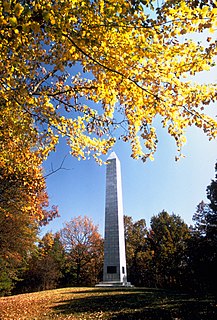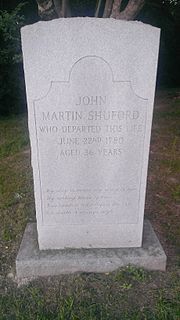Prelude
Tories in the area began raiding and plundering Whig properties, and in early June 1780 established a camp at Mobley's Meeting House, about 12 miles (19 km) north of Shirer's Ferry, located on a high embankment on a branch of the Little River in Fairfield District. They were under the general command of Colonel Robert Coleman of Fairfield District, Colonel Joseph Fleuquinyan and Captain William Nichols. This group had plundered many of the possessions of Whigs in the area, in particular members of the Hampton family, and had sent John and Henry Hampton as prisoners to Lord Cornwallis at Camden. Thus laden down with booty, they awaited British assistance.
Richard Winn, a prominent Whig leader in the area, began to rally supporter to his side. By June 7 he had rallied a force of between one and two hundred men in the New Acquisition District (roughly York County, South Carolina). Its principal commanders were Colonel William Bratton, who had been leading Whig militia since the war began in 1775, as well as Colonels Edward Lacey, John McClure, Samuel Watson, Cooper, and William Hill. This group was composed in large part of the Whig forces that had just the day before routed and scattered a Tory gathering at Beckhamville, South Carolina. Colonel Bratton was elected overall field commander for the engagement, which rode for Mobley's that day, arriving in the early morning hours. They found that the camp, although it had a fortified blockhouse and the meetinghouse itself was of sturdy construction, was not particularly alert against possible attack, and planned a surprise attack.

Andrew Pickens was a militia leader in the American Revolution. A planter, he developed his Hopewell plantation on the east side of the Keowee River across from the Cherokee town of Isunigu (Seneca) in western South Carolina.

The Battle of Kings Mountain was a military engagement between Patriot and Loyalist militias in South Carolina during the Southern Campaign of the American Revolutionary War, resulting in a decisive victory for the Patriots. The battle took place on October 7, 1780, 9 miles (14 km) south of the present-day town of Kings Mountain, North Carolina. In what is now rural Cherokee County, South Carolina, the Patriot militia defeated the Loyalist militia commanded by British Major Patrick Ferguson of the 71st Foot. The battle has been described as "the war's largest all-American fight".

Benjamin Cleveland was an American pioneer and officer in the North Carolina militia. He is best remembered for his service as a colonel in the Wilkes County Regiment of the North Carolina militia during the War of Independence, and in particular for his role in the American victory at the Battle of Kings Mountain.

The Battle of Waxhaws took place during the American Revolutionary War on May 29, 1780, near Lancaster, South Carolina, between a Continental Army force led by Abraham Buford and a mainly Loyalist force led by British officer Banastre Tarleton. Buford refused an initial demand to surrender, but when his men were attacked by Tarleton's cavalry, many threw down their arms to surrender. Buford apparently attempted to surrender. However, the British commanding officer Tarleton was shot at during the truce, causing his horse to fall and trap him. Loyalists and British troops were outraged at the breaking of the truce in this manner and proceeded to fall on the patriots.

Kings Mountain National Military Park is a National Military Park near Blacksburg, South Carolina, along the North Carolina/South Carolina border. The park commemorates the Battle of Kings Mountain, a pivotal and significant victory by American Patriots over American Loyalists during the Southern Campaign of the Revolutionary War. It was listed on the National Register of Historic Places in 1996. Thomas Jefferson considered the battle "The turn of the tide of success."
South Carolina was outraged over British tax policies in the 1760s that violated what they saw as their constitutional right to "no taxation without representation". Merchants joined the boycott against buying British products. When the London government harshly punished Massachusetts for the Boston Tea Party, South Carolina's leaders joined 11 other colonies in forming the Continental Congress. When the British attacked Lexington and Concord in the spring of 1775 and were beaten back by the Massachusetts Patriots, South Carolina rallied to support the American Revolution. Loyalists and Patriots of the colony were split by nearly 50/50. Many of the South Carolinian battles fought during the American Revolution were with loyalist Carolinians and the part of the Cherokee tribe that allied with the British. This was to General Henry Clinton's advantage. His strategy was to march his troops north from St. Augustine, Florida, and sandwich George Washington in the North. Clinton alienated Loyalists and enraged Patriots by attacking a fleeing army of Patriot soldiers who posed no threat. Enslaved Africans and African Americans chose independence by escaping to British lines where they were promised freedom.

The Battle of Fishing Creek, also called the Battle of Catawba Ford, was an American Revolutionary War battle fought on August 18, 1780, between American and British forces including the 71st Foot. It was fought near the junction of Fishing Creek and the Catawba River in South Carolina. British forces under Banastre Tarleton surprised the militia company of Thomas Sumter, killing a significant number, taking about 300 captives, and very nearly capturing Sumter, who some say was asleep at the time of the attack.
The Battle of Colson's Mill was a battle of the American Revolutionary War that took place in North Carolina on July 21, 1780. A Patriot militia under William Lee Davidson scattered a gathering of Loyalists at Colson's Mill, near the junction of the Rocky and Pee Dee Rivers in present-day Stanly County, North Carolina.

Griffith Rutherford was an officer in the American Revolutionary War, a political leader in North Carolina, and an important figure in the early history of the Southwest Territory and the state of Tennessee.

The Battle of Ramsour's Mill took place on June 20, 1780 in present-day Lincolnton, North Carolina, during the British campaign to gain control of the southern colonies in the American Revolutionary War. The number of fighters on each side of the battle is still an issue of contention, but Loyalist militiamen outnumbered Patriot militia and had captured a group of Patriots who they were planning to hang on the morning of June 20.

John Bratton was a U.S. Representative from South Carolina, as well as a general in the Confederate States Army during the American Civil War. He rose from private to brigadier general and led a regiment and brigade in the Army of Northern Virginia in several important battles in both the Eastern Theater and Western Theater during the war.

The Battle of Musgrove Mill, August 19, 1780, occurred near a ford of the Enoree River, near the present-day border between Spartanburg, Laurens and Union Counties in South Carolina. During the course of the battle, 200 Patriot militiamen defeated a combined force of approximately 300 Loyalist militiamen and 200 provincial regulars.
The Battle of Rocky Mount took place on August 1, 1780 as part of the American Revolutionary War. 600 Loyalists commanded by Lieutenant Colonel George Turnbull occupying an outpost in northern South Carolina withstood an attack by 300 American Patriots led by Colonel Thomas Sumter.
The Battle of Hanging Rock was a battle in the American Revolutionary War that occurred between the American Patriots and the British. It was part of a campaign by militia General Thomas Sumter to harass or destroy British outposts in the South Carolina back-country that had been established after the fall of Charleston in May 1780.
Major Joseph Caldewll McJunkin was an American Revolutionary War patriot serving in the battle of Kings Mountain, North Carolina.
Huck's Defeat or the Battle of Williamson's Plantation was an engagement of the American Revolutionary War that occurred in present York County, South Carolina on July 12, 1780, and was one of the first battles of the southern campaign to be won by Patriot militia.
The Battle of Wahab's Plantation was a surprise attack on a Loyalist camp, which included elements of the British Legion commanded by Banastre Tarleton, by Patriot militia under the command of William R. Davie on September 21, 1780. The owner of the plantation was militia Captain James A. Walkup who served as a guide for Davie prior to the attack. Confusion has arisen over the spelling of the name Wahab as there are many spellings of the surname including, Walkup/Wahab/Wauchope/Waughup. The Loyalists were camped on the west side of the Catawba River while General Charles Cornwallis' army had camped on the east side. Davie opportunistically decided to attack the Loyalist camp, and succeeded in driving them back in complete surprise and with heavy casualties. He retreated before the British regulars arrived. The latter, in revenge for the attack, burned down Captain Walkup's house.
Events from the year 1780 in the United States.
William "Bloody Bill" Cunningham (1756–1787) was an American loyalist infamous for perpetrating a series of bloody massacres in South Carolina's backcountry in the fall of 1781 as commander of a Tory militia regiment in the Revolutionary War. Though his family were loyal to the British crown, Cunningham initially enlisted in the Continental Army as part of the State of South Carolina's 3rd regiment in 1775. His tenure in the rebel army was an unhappy one and Cunningham changed sides to fight for the British in 1778. He earned the nickname "Bloody Bill" for the violent, ruthless nature of his raids on rebels and patriot civilians.
Christian Huck (1747/8-1780) was a Loyalist soldier from Philadelphia during the American Revolutionary War known for Huck's Defeat.










